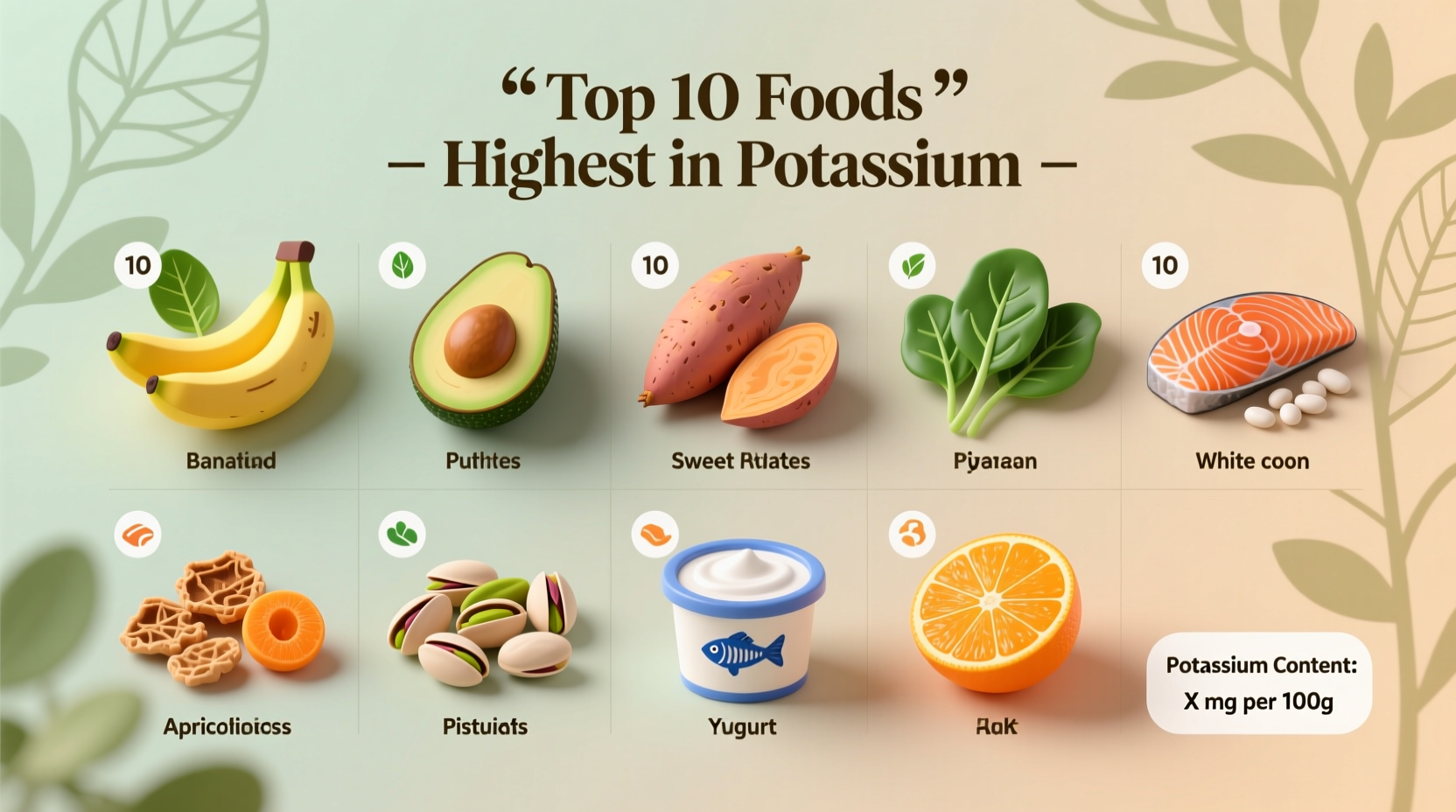The top potassium-rich foods include white beans (1,004mg per cup), sweet potatoes (542mg per medium potato), spinach (839mg per cooked cup), avocados (708mg per whole fruit), and bananas (422mg per medium fruit). Adults need 2,600-3,400mg daily for optimal heart, muscle, and nerve function. This guide provides exact measurements, practical meal integration strategies, and important considerations for different health conditions.
Understanding which foods contain the most potassium is essential for maintaining proper heart function, blood pressure regulation, and muscle health. Potassium works with sodium to maintain fluid balance in your body, and getting enough through your diet can significantly reduce the risk of stroke and hypertension. The National Institutes of Health recommends adults consume 2,600mg (women) to 3,400mg (men) daily, yet most people fall short of these targets.
Why Potassium Matters More Than You Think
While many focus on reducing sodium, increasing potassium intake may be equally important for cardiovascular health. Research from the American Heart Association shows that a potassium-rich diet can lower blood pressure by 4-5 mm Hg in people with hypertension. Potassium helps your kidneys remove excess sodium through urine, directly impacting blood pressure regulation. It also supports proper nerve signaling and muscle contractions—including your heartbeat.
Top Potassium Foods: Exact Measurements
When evaluating potassium content, serving size matters significantly. Many "high-potassium" lists fail to account for realistic portion sizes. We've compiled data from USDA FoodData Central to show which foods deliver the most potassium per typical serving:
| Food | Serving Size | Potassium (mg) | % Daily Value |
|---|---|---|---|
| White beans (cannellini) | 1 cup, cooked | 1,004 | 22% |
| Sweet potato | 1 medium, baked | 542 | 12% |
| Spinach | 1 cup, cooked | 839 | 18% |
| Avocado | 1 whole fruit | 708 | 15% |
| Banana | 1 medium | 422 | 9% |
| Salmon | 3 oz, cooked | 534 | 11% |
| Yogurt (plain, nonfat) | 1 cup | 579 | 12% |
Maximizing Potassium Absorption: Practical Strategies
Simply knowing which foods contain potassium isn't enough—you need practical ways to incorporate them into your daily routine. Unlike supplements, food sources provide potassium alongside other nutrients that enhance absorption and utilization.
Breakfast Boosters
Start your day with potassium-rich options that beat the standard banana:
- Add 1/2 avocado to whole grain toast with a sprinkle of pumpkin seeds (680mg total)
- Blend spinach, banana, and plain Greek yogurt into a smoothie (950mg)
- Prepare oatmeal with mashed sweet potato instead of fruit (700mg)
Lunch and Dinner Solutions
Transform ordinary meals into potassium powerhouses:
- Replace rice with quinoa and add white beans to salads (1,200mg per serving)
- Use sweet potato instead of regular potatoes in roasted vegetable medleys
- Create bean-based soups that freeze well for quick potassium-rich meals

Context Matters: Special Considerations
While potassium benefits most people, certain health conditions require careful management. Individuals with chronic kidney disease must often restrict potassium intake, as damaged kidneys cannot properly remove excess potassium from the blood. The National Kidney Foundation recommends working with a renal dietitian to determine appropriate levels.
For those on certain medications like ACE inhibitors or potassium-sparing diuretics, excessive potassium can cause dangerous hyperkalemia. Always consult your healthcare provider before making significant dietary changes if you have kidney issues or take medications affecting potassium levels.
Potassium-Rich Food Showdown: Making Smart Choices
When comparing similar foods, small differences significantly impact your daily intake:
| Food Comparison | Potassium (mg) | Practical Tip |
|---|---|---|
| White beans vs. kidney beans (1 cup) | 1,004 vs. 717 | Choose white beans for 40% more potassium |
| Spinach (cooked) vs. raw (1 cup) | 839 vs. 157 | Cooking concentrates potassium—3x more per serving |
| Avocado vs. banana (per serving) | 708 vs. 422 | Avocado delivers 67% more potassium than banana |
| Plain yogurt vs. fruit-flavored (1 cup) | 579 vs. 380 | Avoid added sugars that dilute nutrient density |
Avoiding Common Potassium Pitfalls
Many people make these mistakes when trying to increase potassium intake:
- Over-relying on bananas: While convenient, they're not the most potent source
- Choosing processed versions: Canned beans with added salt counteract benefits
- Ignoring cooking methods: Boiling leaches potassium into water—steam or roast instead
- Misjudging portions: A whole avocado delivers more potassium than three bananas
For optimal benefits, focus on whole food sources rather than supplements. The NIH reports that potassium from food sources is safer and more effective than supplements for most people, as it comes with fiber, vitamins, and other minerals that work synergistically.
Your 7-Day Potassium Meal Plan
Implement these realistic strategies without overhauling your entire diet:
- Monday: Avocado toast with pumpkin seeds + spinach smoothie (1,600mg)
- Tuesday: White bean soup with sweet potato chunks (1,800mg)
- Wednesday: Salmon salad with edamame and avocado (1,500mg)
- Thursday: Lentil curry with spinach and yogurt (1,700mg)
- Friday: Baked sweet potato with black beans and salsa (1,650mg)
- Saturday: Mushroom and spinach omelet with avocado (1,400mg)
- Sunday: Bean chili with banana for dessert (1,900mg)
This approach ensures you consistently hit 1,400-1,900mg daily from food sources, which when combined with other potassium-containing foods throughout the day, easily meets recommended targets.











 浙公网安备
33010002000092号
浙公网安备
33010002000092号 浙B2-20120091-4
浙B2-20120091-4